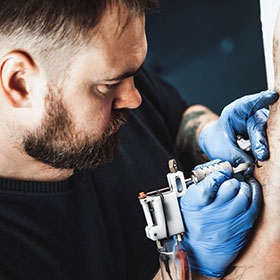Yes, it is normal for a tattoo to scab. After getting a tattoo, your skin undergoes a healing process.
Scabbing is a natural part of this process. Getting a tattoo involves needles piercing your skin. This creates a wound that needs to heal. As with any wound, your body forms scabs to protect the area. These scabs help prevent infection and aid in the healing process.
While it may be concerning to see your tattoo scab, it is a common and expected part of healing. Proper care is essential to ensure your tattoo heals well and looks great. In this blog, we’ll explore why scabbing happens, how to care for your tattoo, and what signs to watch for during the healing process. Stay tuned for helpful tips and advice!
Healing Stages Of A Tattoo
The first stage of tattoo healing starts right after the tattoo is finished. The area will feel sore and tender. There might be some redness and swelling. During this period, the body starts to form a scab. This is a part of the natural healing process. Do not pick at the scab. Picking can cause infections and scarring. Keep the tattoo clean and moisturized.
In the second stage, the tattoo may become itchy. This is because the skin is drying and peeling. Do not scratch the tattoo. Scratching can harm the new skin. Apply a gentle moisturizer to ease the itching. The scabs may start to fall off. This is normal. Let them fall off naturally.
In the final stage, the tattoo looks dull and cloudy. This is because the new skin is still healing. Over time, the tattoo will brighten. It is important to keep the tattoo protected. Use sunscreen to prevent fading. The skin will continue to heal over the next few months. Proper care ensures the tattoo looks vibrant.
Signs Of Normal Scabbing
A new tattoo may scab. This is a part of healing. Scabs often appear dry and flaky. They might be small and thin. Sometimes, they are thicker and rough. Normal scabs can be dark or light in color. They form over the inked area.
Scabs should not be too big. Large scabs might mean a problem. Normal scabs do not hurt much. They might itch a bit. Do not pick at scabs. This helps them heal.
Scabs usually last for one to two weeks. They start small. Then they grow. After a few days, they shrink. Scabs fall off when ready. This may take time. Do not rush it. Patience is key.
When To Be Concerned
A scab forming on a new tattoo is normal, but excessive scabbing can signal an issue. Seek advice if the scab is thick, painful, or oozing.
Infection Indicators
Swelling, redness, and heat around the tattoo can be signs of infection. Look for pus or yellowish fluid. Fever and chills might also mean an infection. Pain that gets worse over time is not normal. Bad smell from the tattoo area is another warning sign. Seek medical help if these symptoms appear.
Abnormal Scabbing
Thick, hard scabs are not normal. They can lead to scarring and damage the tattoo. Bleeding from the scabs is also a concern. If the scabs last more than two weeks, it might be a problem. Itching and cracking scabs can cause infections. Gently wash the area and apply a moisturizer if needed.
Proper Aftercare Techniques
Cleaning your tattoo is very important. Use warm water and mild soap. Gently wash the area. Do not scrub hard. Pat it dry with a clean towel. Do this twice a day. Clean hands before touching the tattoo.
Keep your tattoo moisturized. Use a thin layer of fragrance-free lotion. Apply it after cleaning the tattoo. Do not over-moisturize. Too much moisture can delay healing. A scab may form. That is normal. Do not pick at the scab.
Avoiding Complications
Tattoo scabbing is a normal part of the healing process. It helps protect the skin and prevent infection. Avoid picking at the scabs to prevent complications.
Activities To Avoid
A new tattoo needs special care to heal well. Avoid swimming in pools or oceans. Water can introduce bacteria to your tattoo. This can cause infections. Skip heavy exercise. Sweat can irritate your tattoo. It may also slow down healing. Do not expose your tattoo to direct sunlight. UV rays can damage the skin and fade the ink.
Clothing And Bedding
Wear loose clothing over your tattoo. Tight clothes can rub against the tattoo. This can cause irritation and scabbing. Choose soft fabrics. Rough materials can make the tattoo area uncomfortable. Keep your bedding clean. Change sheets regularly. Dirty bedding can carry bacteria. This can lead to infection. Avoid sleeping on the tattooed area. Pressure can disturb the healing process.
Products To Use And Avoid
Use fragrance-free lotions. Unscented products are best. Antibacterial ointments help healing. Petroleum jelly keeps the skin moist. Vitamin E oil soothes the area. Coconut oil can be used. Choose natural options when possible. Look for hypoallergenic labels.
Avoid alcohol in products. It dries the skin. Fragrances can irritate. Parabens may cause allergies. Lanolin is not good for everyone. Mineral oil can clog pores. Artificial colors may harm healing. Strong chemicals are risky. Check labels carefully.
Managing Pain And Discomfort
Applying a cold compress can help reduce pain. Over-the-counter pain relievers like ibuprofen can also help. Avoid aspirin as it may increase bleeding. Keeping the tattoo clean is very important. Clean it gently with mild soap and water. Do not scrub the area. Pat it dry with a clean towel.
Scabs can cause itchiness. Do not scratch the tattoo. This can damage the skin. Apply a thin layer of unscented lotion to keep the skin moist. A cold compress can also help with itching. Wear loose clothing to avoid irritation. Keep the tattoo out of direct sunlight.
When To Consult A Professional
Experiencing scabbing on a new tattoo is common. Consult a professional if you notice excessive redness, swelling, or pus. These signs may indicate an infection.
Tattoo Artist Advice
Your tattoo artist knows best. Follow their care tips closely. Do not pick or scratch the scabs. Keep the tattoo clean and moisturized. If you see unusual signs, ask your artist. They can tell if it’s normal or not. Trust their experience.
Medical Professional Help
If the skin around the tattoo is red or swollen, seek help. Pain that gets worse is a bad sign. Pus or a foul smell means infection. These signs need a doctor. Quick action can stop a serious problem. Better safe than sorry.
Conclusion
Scabbing is a normal part of the tattoo healing process. It helps protect the new ink. Don’t pick at the scabs. This can cause damage and infection. Keep your tattoo clean and moisturized. Follow your artist’s aftercare instructions. Patience is key during healing.
Everyone’s skin heals differently. If you notice unusual symptoms, consult your artist or a doctor. Proper care ensures a beautiful, lasting tattoo.

